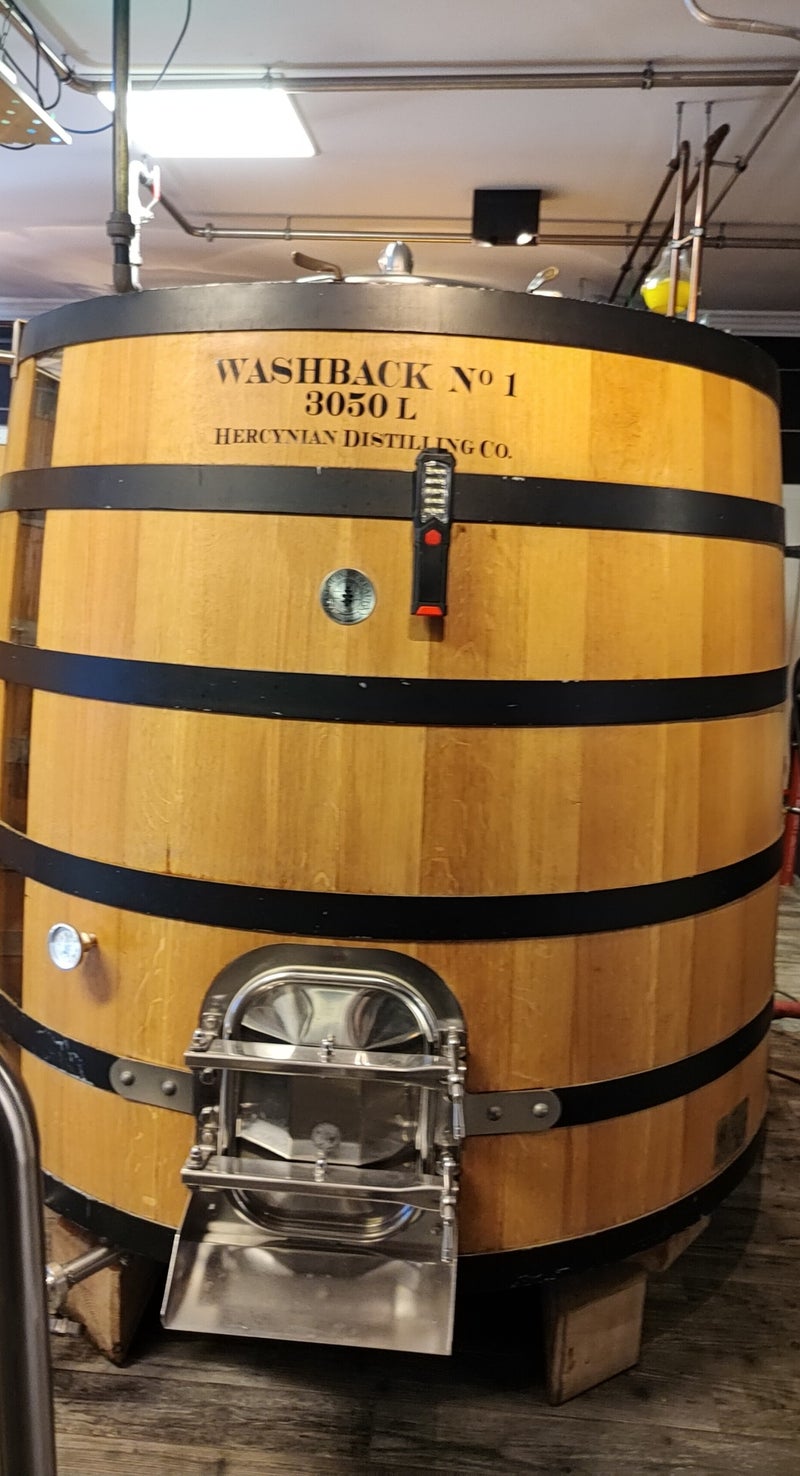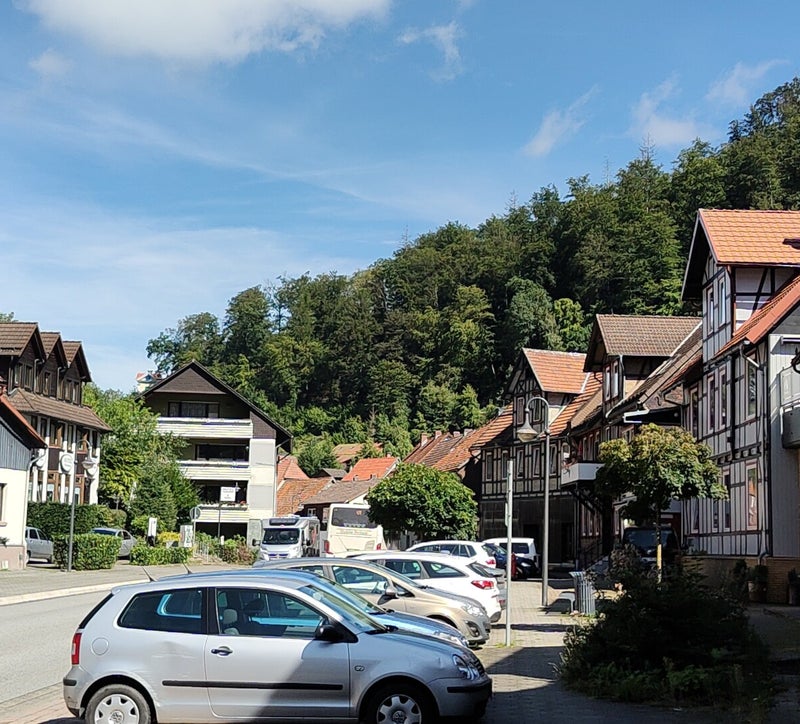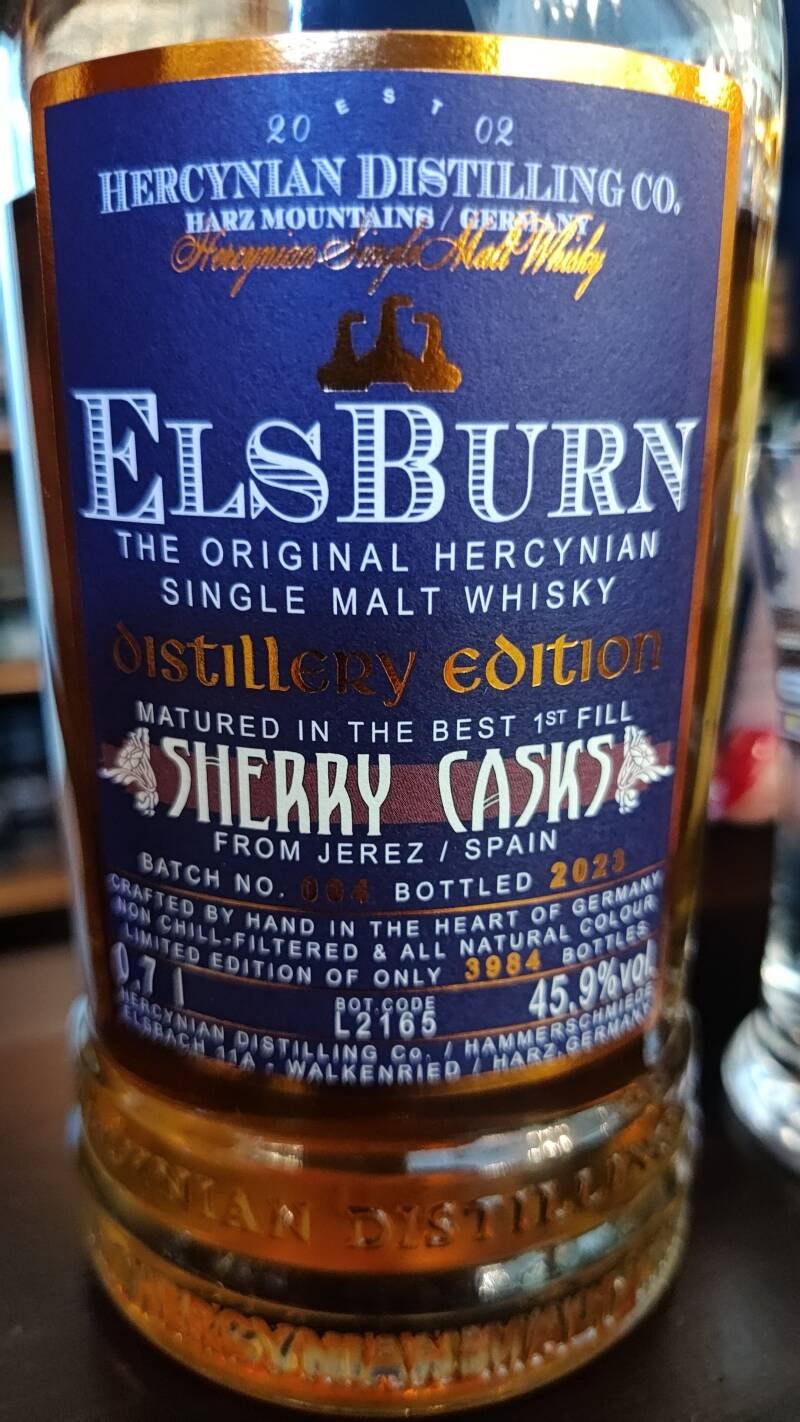
Off the train from Göttingen, I boarded a bus up into the hills on the edge of the Harz Mountains. In the peak of summer, the hills are dark green with dense forests, and in the middle of a close-shouldered valley lies Hercynian Distilling Company.
The stream here, the Elsbach, gives its name to some of the whiskey made here in the heart of Germany, in the form of the slightly anglicized Elsburn . That said, there's a few other names to clear up. Hammerschmiede is the name of the distillery itself, having started back in 1895.
If you see someone refer to this whiskey as Glen Els , that's what it used to be called (again referring to the Elsbach) until the overprotective and over-litigious SWA put a stop to that .
The distillery may be relatively small, but it has a great shop for visitors. For my visit, I was greeted by the two Annas. While both of them make Hercynian tick, one Anna (their head distiller) is the one who showed me around, so that's who I'm referring to below when I say 'Anna'!
History & Context
Like Habbel, which I had visited the day before, Hammerschmiede Distillery traces its roots back to a time before modern whiskey regulations, when rougher grain spirits were produced all over Europe. Just down the road, the imperial abbey of Walkenried also used to distil - part of a long tradition of alcoholic production from abbeys across Europe!
Whereas Hammerschmiede had historically made herbal liqueurs, that all changed when Anna came into the picture. Under her direction, Hercynian Distilling Co. began producing single malt. Anna's approach to this shift was long-term. Hercynian only started describing herself as a 'whisky distillery' when they had 100 casks, she says - not after the first one.
Anna isn't just any employee - she's part of the family business. Indeed, Hercynian highlights the difference between family-owned and family-run. Just because a family owns a whiskey distillery doesn't mean they are actually the ones doing the production, but at Hercynian, Anna is 100% hands-on.
A lot of hay is made about Anna's work as a woman working in whisky, and she is certainly a kind of trailblazer in that regard alongside names like Annabel Thomas and Angela D'Orazio . However, don't mistake this for family nepotism or tokenism. Not only is Anna highly experienced (with whiskey which speaks for itself), but I can see her frankly ruthless commitment to the craft of distilling throughout my tour.


We discussed this legacy of change during the tour - how women were historically such a large part of brewing and distilling, until the Industrial Revolution saw them increasingly sidelined. Anna represents one more example of how things are now improving, particularly regarding the internal divisions within the whiskey industry. Thankfully more women are now working in production and decision-making, not “just” supporting roles like marketing and administration.
(I say “just” because those are obviously important too - they just shouldn't be the only roles women are doing in the whiskey industry!)
All this, and there's the question of where Hercynian sits within the wider German whisky industry. Is it relatively small? Big? An outlier, or a leader? 'Some say we're a spearhead' for German whisky, Anna says, but she also reflects that it's sad, in a way. It says something about the variable quality of other whiskeys across Germany that Hercynian is sometimes held up as 'one of the good ones' (that's not a direct quote!).
Compare the enormous number and variety of whiskey distilleries in Germany to somewhere like Denmark. Anna seems to love Danish whisky as much as I do - it's perhaps the best countrywide whiskey industry in Europe now in terms of consistent quality. Scotland and Ireland, meanwhile, are so successful because their floor for quality is high, and the relative price is low due to economies of scale.
It's a challenging environment to compete in - so let's get into how whiskey is made at Hammerschmiede!
Local Materials
Barley is the only grain that grows here on the edge of the Harz, Anna explains. For that reason, single malt is actually a very appropriate spirit to produce here. For comparison, their herbal liqueurs need 35 ingredients, and only 7 to 10 of those are locally sourced.
So the barley used comes from a maximum 50km away around the Harz - most are closer than 20km. The locally smoked malt used to make Hercynian's Alrik is not cheap. A tonne of local Harz barley costs €800 - a tonne of smoked, more like €2500!
Likewise, the wood used for the stills (yes, you read that right - see below) is all locally grown lumber. Locally sourced material even includes the copper used in the stills! Anna points to the forest opposite, whose trees are all maximum 100 years old because, before that point, this area was a copper mine. Double distillation isn't just a Scottish practice - local monks in the area used to do it too.
Making whiskey locally and on a small scale means you are subject to the whims of changing supply. After all, this is part of the reason so many big Diageo distilleries want to scale up and draw in materials from far and wide - it's all insurance against this kind of variation.
In 2018, a really hot summer in the Harz (with no rainfall at all between April and October) meant there was no water for production at Hercynian. Some years, they only produce 12,000L instead of the normal 35,000.
That said, reliance on local materials can also be helpful. For example, during the COVID-19 lockdowns across the world, having such short supply chains meant Hercynian's production was impacted less than you might imagine.
Oh, and Hercynian's water doesn't come from the Elsbach itself, but from a spring 700m away on the nearby Großer Stauffenberg .


Production
The Details:
- 500kg malt per batch
- 1 tonne stainless steel lauter mash tun (half-filled)
- Three sparges of 30, 84, and 93C
- 2500L of wort fermented using M1 yeast for 96 to 120 hours (usually 120)
- 3050L wooden washbacks (no switcher blades to break up foam, so never fully filled - don't want any overflowing!)
- Double distillation in direct-fired, wood-fired pot stills
- 2 wash stills (700L) and one spirit still (800L)
- Wash stills (with an ascending lyne arm) filled to 500L, producing 25% ABV low wines
Their mash ferments at a warmer temperature than some, which Anna explains is one way to increase lacto-fermentation. interestingly, she is quite precise about which flavors this produces - grapefruit, lime, and raspberry. It would certainly explain the raspberry notes of the unpeated new make (similar to the strawberry I could smell at Mworveld ).

I assumed that wood fires were lower temperature than the gas heating often used today, but even as I asked, I realized that didn't make sense. Modern stills use steam heating, so by definition they will never heat to over 100C (unless using superheated steam). The higher maximum heat of wood firing means that the base of these stills need to be thicker than normal.


Anna lets me nose some Elsburn new make, and she's right - it has notes of raspberry. She says the Willowburn new make is her personal favorite.
Hercynian Distilling Co. produces around 150 to 200 casks each year, translating to 50,000 bottles (or 700ml) per year. Their annual output is therefore approximately 35,000 LPA. By contrast, Anna claims that the annual demand for their whiskeys amounts to somewhere between 4 and six times their current output.
Just as I picture the drastic expansions taking place at distilleries like Bruichladdich and Macallan, Anna cites Glenfiddich as an example. This is also an interesting comparison as Glenfiddich is family-owned like Hercynian. However, it isn't family-run - Glenfiddich is far too big a distillery for that to be realistic!

Maturation

The whisky ages in three warehouses: the old Wieda blacksmith building, a racked warehouse, and a dunnage. Anna walks me around the racked warehouse, kicking casks while explaining how Hercynian whiskey ages.
The key word here is sherry. About half of Hercynian's total range of casks are sherry hogsheads. Only 2% are American oak! Of the remainder, about half are Malaga or Port, while the remainder includes everything from Marsala to Madeira, and Banyuls to Moscatel.
Don't expect to see cask finishes or other types of wood either. Hercynian is highly traditional, at least with regard to cask choice. Anna likes this approach to what Macallan did back in the heydays of the 1960s.
More than that, most Hercynian bottlings are cask strength. Everything is non chill filtered - there's no caramel colouring. They don't even filter out the fins from the casks! Every bottle is filled and sealed by hand. Their bottles and packaging are also manufactured locally.
If you want whiskey 'as it is', aged in a transparent and robust manner that complements a robust style of malt, then this is what makes it work - this is what makes Hercynian whiskey such a heavy hitter. The game they play is very similar to Glendronach, Anna says (rightly in my opinion). Cask strength, leaning into sherry maturation, and a small range of regular bottlings.
The climate around Hammerschmiede is similar to Scotland's but the aging is still accelerated to an extent at 3 to 5% per year of angels' share. Humidity plays a role as much as temperature. Under German law, the cellars full of aging Hercynian casks must be flushed with pressurized air every 30 minutes to reduce the risk of fire caused by alcohol vapours. The limit is 200ppm of alcohol vapor in air - for comparison, the Scottish limit is 2000ppm, so this is pretty strict!

Tasting

Hercynian started with Elsburn in 2006. This is an unpeated expression aged in sherry, and the potent cask flavors are certainly potent ! Rich, powerful sherry aromas that should delight any Glenfarclas or Glendronach fan - its spirit style might be a little closer to the former, but their casks are more reminiscent of the latter. That said, Hercynian malt has a wider range of fruit in its new make than either of those Scottish distilleries.


Next, I tried an 11 year old PX Elsburn expression: nine years in PX before another two and a bit years in sherry octaves. This dram is (understandably) more expensive, and the overlapping sherry casks give it an intensely dark color. The flavor is also extremely intense, loaded with blackcurrant and coffee . I've had a fair few heavy PX drams, but this is likely the most intense I've ever had!

In 2007, Hercynian produced a new expression using 100% wood-smoked malt, the Alrik named for a town in neighboring Thuringia. Specifically, alder and beech smoke are used, being common trees growing in the area (and already common woods for smoking food). Decorated with images from the local myth of a wingless dragon, this bottle is full of vanilla, nuts, and BBQ flavors.


Since 2012, Hercynian has also produced the Emperor's Way . This is a peated dram, with some peat coming from the Harz and some peated malt coming from 30ppm malt sourced 80km away in Lower Saxony. The name comes from the main route through the Harz mountains used by Kings and Kaisers in medieval times. The Emperor's Way aged in amontillado really hits a spot - nutty and sweet, not too dry, reeking of peach and apricot.


Imperial Abbey is an Emperor's Way expression with incredibly buttery sherry notes, all dark and bronze. Anna explains there's some palo cortado cask in there as well - no wonder it's so good! Repeat readers may know it's my favorite cask at the moment…
Finally, a lightly wood-smoked single malt is named Willowburn to refer to a local river. The Willowburn Ember specifically won the World Whiskies award for the best German single malt this year, and apparently it's a particular hit with Highland Park fans. I found it very sweet but not sickly - a long depth of finish to enjoy all those strawberry notes. A distillery exclusive, cask strength Willowburn (at 61.7%) has a darker edge than the standard variety.
What does the future hold?


Unlike many big Scottish distilleries, Hercynian does not plan to drastically increase their output to match the high demand. This is a matter of philosophy (and, however in/directly, sustainability). Anna believes that the whiskey world doesn't need more whisky, at least in terms of quantity - instead, better quality is always welcome.
With their current setup, Hercynian could immediately double production without changing their setup at all. Anna notes that if they stopped the current silent season each summer and used night shifts, Hercynian could even quadruple or sextuple their current output! It's all the more proof that the decision not to expand is a philosophical one.
You can visit - and you should! Hercynian is perhaps the best place for fans of 1960s Scotch whiskey production to see (and taste) how it was done. The distillery location is in a gorgeous area (and you can take the nearby Harz Schmalspurbahn , which I did the following day).
Hercynian does get quite busy with visitors, especially on weekends, but it's a true destination - no feeling sad on a visit to a faceless industrial estate with this whisky distillery! Visiting is also one of the best ways to get hold of their whiskey, as most is sold within Germany. Only a little gets exported to France, the Netherlands, and the UK.


Add comment
Comments